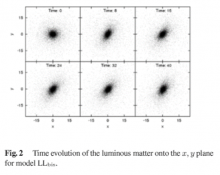
Abstract
The radial-orbit instability is a collective phenomenon that has heretofore only been observed in spherical systems. We find that this instability occurs also in triaxial systems, as we checked by performing extensive N-body simulations whose initial conditions were obtained by sampling a self-consistent triaxial model of a cuspy galaxy composed of luminous and dark matter. N-body simulations show a time evolution of the galaxy that is not due to the development of chaotic motions but, rather, to the collective instability induced by an excess of box-like orbits. The instability quickly transforms such models into a more prolate configuration, with 0.64<b/a<0.77 and 0.6<c/a<0.7 for the dark halo and 0.64<b/a<0.77 and 0.59<c/a<0.67 for the luminous matter. Stable triaxial, cuspy galaxies with dark matter halos are obtained when the contribution of radially-biased orbits to the solution is reduced. These results constitute the first evidence of the radial-orbit instability in triaxial galaxy models.